One-Quarter of Teens with Dating Experience Have Met Someone Online; Facebook Is the Primary Venue for Meeting Partners Online
A majority of teens with dating experience (76%, or 26% of all teens) say they have only dated people they met via in-person methods. Still, a quarter of teen daters (24%, or 8% of all teens) have dated or hooked up with someone they first met online. Half of this group (representing 12% of all teens with dating experience, or 4% of all American teens) have met just one romantic partner online, while the other half have met more than one partner online. Among teens with dating experience, boys and girls are equally likely to say they have met someone online, and younger and older teens are equally likely to have experienced this as well. Overall, 4% of all teens ages 13 to 14 have dated someone they met online, compared with 11% of all teens ages 15 to 17.
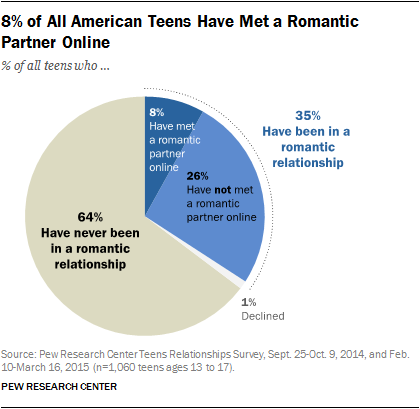
The survey also found that among teen daters who have met a romantic partner online, Facebook is cited more often than other sites as the primary source for online romantic connections. Facebook was mentioned 46 times in the open-ended responses to this question, while the second-most popular (Instagram) was cited only eight times. Twitter, Kik and online gaming also were mentioned in a small number of responses, as were a range of other social media, video and chat sites (Hot or Not, IMVU, MySpace, Omegle, MeetMe and SnapChat each were mentioned once in these responses).
For teens who meet romantic partners online, it is common for those relationships to never actually progress to the point of a physical meeting. Some 31% of teens who have met a partner or partners online, indicate that they have been involved in a romantic relationship with someone online they never met face to face, while 69% of teens who have met a romantic partner online say they have met them in person. Overall, 3% of all teens have met a romantic partner online but never met them in person.
Teens describe experiences meeting romantic partners online
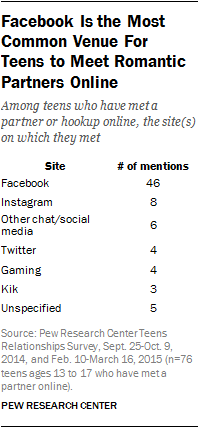
Teens in our focus groups related their experiences meeting partners through online venues. A high school girl described meeting a boyfriend online:
“For me personally, it was from Facebook and it was a friend of a friend. And then like we just like really liked each other. I don’t know. We could talk to each other really easily. And then we started Skyping, and after that we just kind of started a relationship.”
A high school girl described the process she used to meet a guy via Instagram:
“I’ve met a person over Instagram, actually. And, I mean, you…it’s not like you just kind of comment on their picture like, hey, here’s my number. Text me and let’s hang out. Like you can do that. But for me, I DMed the person. Direct messaged them. And we talked for about a week, and then I decided he actually seems kind of chill. I’m going to give him my number. And then I took it slow, like, ‘cause meeting someone over the Internet isn’t always the best idea. So if you’re going to do it, like do it very carefully.”
And this same high schooler eventually met her beau in person:
“Well, I said…we just said, like, do you want to hang out at the movies sometime? I said sure. And we kind of met there and then we just kind of became romantically involved. But it didn’t last that long.”
One high school boy explained how he met a girlfriend through a dating app:
[town]
And this same teen explained that he never met his online girlfriend while they were together:
“Yeah, I met her in person. After we dated. Broke up and then we finally met.”
And for some teens, online relationships, like offline ones, can be uncomfortable and devolve into creepy situations. One high school girl related the experience of one of her friends:
High School Girl: “She met this guy through Facebook and … it feels weird. But he said he lived in Florida and then last weekend, she got a ring in the mail from him. Yeah. And so … I don’t know. She just had a lot of problems with him and she…they talk all the time, but it just … I don’t know. It’s weird.
Interviewer: “But she gave him her address?
High School Girl: “She didn’t give it to him. One of her friends did. And so she told him that it was the wrong address because he asked her. He asked, like, did you get what I sent you? And she was like, that’s not my address. So I don’t know. I just feel weird about the whole situation. I told her she should just, like, leave it, but she doesn’t want to, I guess.”
Teens Use Social Media and Search to Connect With and Research Potential Romantic Partners
Teens deploy social media and the web of connections they create to help them connect with and learn more about potential romantic prospects. One-in-five (20%) of all teens have used their social networks to find new partners by following or friending someone because a friend suggested they might want to date them. Older teens are more likely to do this than younger ones; 23% of 15- to 17-year-olds have followed someone at a friend’s behest for dating purposes, while 15% of 13- and 14-year-olds have done so. Boys and girls are equally likely to friend a potential partner on another friend’s recommendation.
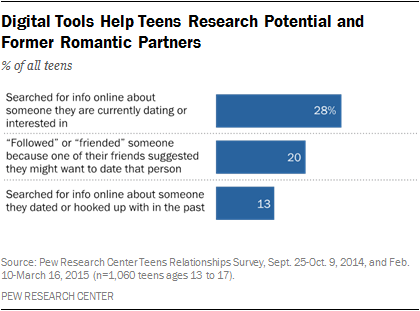
Teens also avail themselves of the search capacities of the internet to connect to more information about romantic prospects. A little more than one quarter (28%) of teens have searched for information online about someone they were currently dating or interested in. And the searching doesn’t end when the relationship is over; 13% of teens (or 38% of teens with dating experience) have ever searched for information online about someone they dated or hooked up with in the past.
Older teens ages 15 to 17 are more likely than younger teens to search for information online about current or prospective romantic partners, with 35% of older teens searching, while 16% of younger teens do so. Similarly, older teens are more likely than younger ones to search for information online about a past romantic partner – while 17% of 15- to 17-year-olds have searched for information about someone they dated or hooked up with in the past, just 7% of all 13- to 14-year-olds have done so.
Much of teens’ research on their potential romantic prospects happens via social media
Given the number of years today’s teens have been using social media and the volume of content posted to social media profiles, potential suitors have access to a motherlode of material on their crush. One high school girl describes falling down the rabbit hole of a crush’s profile. “And then like if you go on their page, then you end up on their next page. You know who their mom is already.” A middle school boy describes his social media research, “Well sometimes you might use social media to see if, like, they’re going out with someone or something,” and a high school boy uses “ Instagram and Twitter just to see what people are doing.”
Teens use social media resources because, as one high school girl explains: “You want to know everything you can about them.”
The trick, teens say, is not to reveal that you’ve been digging deeply into someone’s profile unless you are ready to make your feelings public. As a high school girl said; “You don’t want to go back and you don’t want to, like, comment on their actual photo from 100 years ago. You don’t want to do that.” Such a move, she noted, will reveal to the profile owner via a notification that you’ve been looking through their profile.
And if the feelings aren’t reciprocated, such liking of old photos can border on disturbing. A high school girl explained:
“It looks a little more creepy. I’d be kind of creeped out if someone mentioned my photos from a long time ago, especially because those photos tend to be very embarrassing. They’re old, and I’m like, why did I post a photo of me?”
Teens Take a Range of Approaches to Let Someone Know They Are Interested in them Romantically
Flirting and otherwise letting someone know you are interested in them is typically the first step to building a romantic relationship, and teens approach this in numerous ways across a range of online and offline venues.

Social media interactions, along with in-person flirting, are among the most common ways for teens to express romantic interest in someone. Half of all teens (50%) have let someone know they were interested in them romantically by friending them on Facebook or another social media site (this represents 65% of teens who use social media), while 47% (representing 62% of social media users) have expressed their attraction by liking, commenting or otherwise interacting with that person on social media. And just over half of teens (55%) flirt or talk to someone in person to let them know they are interested.
Other ways in which teens let someone know that they are attracted to them include sharing something funny or interesting with them online (46%), sending them flirtatious messages (31%), making them a music playlist (11%), sending flirty or sexy pictures or videos of themselves (10%)8 and making a video for them (7%).

Certain types of flirting behavior are relatively common among teens who have never dated before; others are almost entirely the purview of those with past experience in romantic relationships.
Each of the flirting behaviors measured in the survey is more common among teens with previous dating experience than among those who have never dated before. But while some of these behaviors are at least relatively common among dating neophytes, others are engaged in almost entirely by teens with prior relationship experience.
When it comes to “entry-level” flirting, teens who have never been in a romantic relationship are most comfortable letting someone know that they are interested in them romantically using the following approaches:
- Flirting or talking to them in person (39% of teens without dating experience have done this).
- Friending them or taking part in general interactions on social media: Roughly one-third (37%) of teens without dating experience have friended someone they are interested in romantically and a similar 34% have liked, commented on a post or otherwise interacted with a crush on social media.
- Sharing funny or interesting things with them online (31% of teens without dating experience have done this).
On the other hand, more advanced, and sometimes more overtly sexual, online behaviors are used to flirt almost entirely by teens who have prior experience in romantic relationships:
- 63% of teens with dating experience have sent flirtatious messages to someone they were interested in; just 14% of teens without dating experience have done so.
- 23% of teens with dating experience have sent sexy or flirty pictures or videos to someone they were interested in, compared with just 2% of teens without dating experience.
Older teens are more likely than younger teens to have engaged in all of these flirting behaviors; girls and boys take similar steps to express romantic interest

As noted earlier, older teens are more likely than younger teens to have experience with dating and relationships – and as such, older teens are substantially more likely than younger teens to say they have let someone know they were interested in them romantically in all of the ways measured on this survey.
The correlation between flirting behaviors and age, however, is not as strong as the correlation between these behaviors and dating experience. For example, there is a 15-point gap between older and younger teens when it comes to sending flirtatious messages (37% of older teens and 22% of younger teens have done so), but a substantially larger 49-point gap between those who are or have been in a relationship of some kind and those who have not (63% of teens with relationship experience have sent flirtatious messages to someone, compared with just 14% of those without).
There also are some modest differences relating to race and ethnicity in terms of the ways in which teens show interest in potential romantic partners. For instance, Latino teens are more likely than whites to say they have created a music playlist for someone they were interested in dating (14% vs. 8%), while African-American teens are more likely than whites to say they have expressed interest by sending flirty/sexy pictures or videos (15% vs. 8%).
On the other hand, girls and boys take nearly identical steps to show their romantic interest: There are no significant differences between girls and boys on any of these behaviors.
Teens talk about the variety of digital flirting practices they employ
Teens in our focus group described a variety of practices for flirting on social media. One high school girl explained:
“When I have a crush on someone and I want them to know I go on their page and like a lot of pictures in a row.”
A high school boy says he posts “a bunch of emojis under her photo.” And as one high school girl describes, there are ways to signal your level of interest:
“Well, if you’re really putting yourself out there, you could comment on their picture with a heart emoji.”
Texting is also a critical component of early courtship. One high school boy detailed the progression of a flirtation that begins with texting:
“A lot of times when you talk to some you like, you’ll start texting, then you’ll start talking. Then you’ll start talking heavy.”
One high school boy told us:
[…tough]
Another high school girl related the way she used her phone in the digital approximation of old-school note passing:
“I don’t know if you guys do this, but usually if I kind of like the person, if I’m sitting next to them, sometimes I’ll pass my phone to them.”
But not everyone is confident. Some nervous teens find solace and strength in digital methods of flirting such as texting. As one high schooler related, she could be:
“A little bit more bold over text, because you wouldn’t say certain things in person. You would … you just wouldn’t say certain things in, like, talking face to face with them because that might be kind of awkward. But over text, it’s like, OK. Cause they’re not really there.”
And some teens customize their approach based on the particular alchemy of their personality and their crush’s. As one high school girl explained:
“Yeah. I honestly don’t really have, like, a signature flirt type thing. Honestly, it just depends on the person and my personality and theirs.”
Flirting online is challenging and worrisome for some teens, but nonetheless a critical method for expressing interest in someone else
For some teens, flirting by digital means isn’t appealing or workable. One high school girl said:
“I can only ever flirt in person and that is on the rare occasion when I have been gifted with superpowers, clearly.”
Other teens worry about the durability of their flirtations in a social media environment. As one middle school boy told us:
“I wouldn’t do that because, like, once you put something on social media, it’s out there forever. You can’t get it back.”
Digital technology plays a critical role in courtship for many teens. As one high school boy noted:
“It’s going to be hard to impress a girl that you can’t even talk to on the phone or text.”
But use of technology can be a part of a broader strategy where in-person and online flirting work together. As a high school boy put it:
[I]
Girls are Especially Likely to Experience Unwanted Flirting on Social Media
One-quarter of teens have blocked or unfriended someone who was flirting in a way that made them uncomfortable
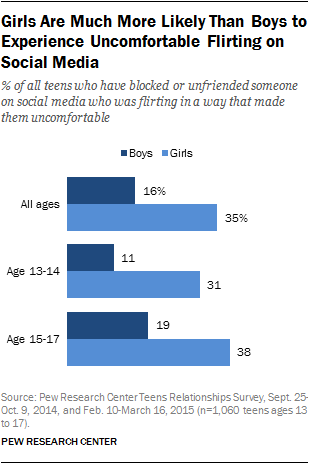
Many teens use social media as a venue to flirt and interact with potential romantic partners, but for those on the receiving end of those advances, social media flirting can often turn in a much less desirable direction. Indeed, 25% of all teens (representing one-third of teen social media users) have unfriended or blocked someone on social media because that person was flirting in a way that made them uncomfortable.
Just as adult women are often subject to more frequent and intense harassment online, teen girls are substantially more likely than boys to experience uncomfortable flirting within social media environments. Fully 35% of all teen girls have had to block or unfriend someone who was flirting in a way that made them uncomfortable, double the 16% of boys who have taken this step.
Notably, this phenomenon is not just limited to older girls who might have greater exposure to dating and relationships. Fully 31% of 13 and 14-year-old girls have blocked or unfriended someone for this reason—this figure is similar to the 38% of older girls who have done so, and nearly triple the rate among 13- and 14-year-old boys.
A high school girl in our focus groups related her experience with uncomfortable online pursuit:
[the app-based messaging service]
Even though girls experience this more often, some boys face uncomfortable flirting and try to manage it through digital means. One middle school boy described an experience he had:
“Well, there was this girl who was kind of crazy for me. One day … she somehow got a hold of my number. And then I didn’t want to talk to her anymore because it was creepy, and she tracked my phone to my house. … She was on the lawn and she used lots of vulgar language … It was awkward and creepy and stalker-ish.”
Liking old photos in people’s profiles struck many as creepy, because it revealed that the person was searching deep into your history. A group of high school boys describe another scenario where flirting becomes unnerving – when the volume of communication became inappropriate:
High school boy 1: “If you just comment on every single…”
High school boy 2: “Or, like, every half hour or something you try and message them on Facebook.”
For Teens, Asking Someone Out in Person Is the Most Common Approach, Although Digital Tools Also Play a Role
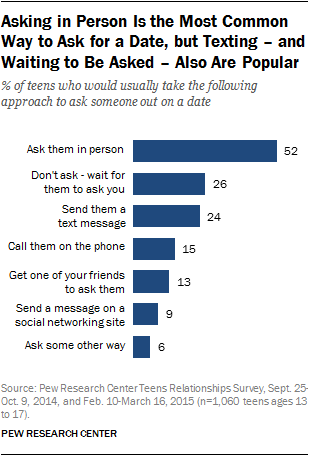
Ultimately, getting someone to actually go out on a date is presumably the primary objective of these various modes of flirting. But despite the wide range of communication technologies available to modern teens, the time-tested tradition of asking in person continues to be the main way teens would ask out someone they were interested in. Some 52% of teens say if they wanted to ask someone out on a date, they would usually do that in person. However, other approaches – online as well as offline – are relatively popular as well:
- 24% of teens say they would usually send a text message if they wanted to ask someone out.
- 15% would call the person they’re interested in on the phone.
- 13% would get one of their friends to ask for them.
- 9% would send a message on a social networking site.
Around one-quarter of teens (26%) say they would not ask at all – that they would wait for the person they were interested in to ask them first – while 6% indicate they would ask the person out using some option other than the ones listed above.
Girls are far more likely than boys to wait for someone they are interested in to make the first move

When it comes to dating, some traditional practices remain common. Girls are far more likely than boys to wait for the person they’re interested in to initiate contact. Nearly half of girls (47%) say they usually wait for someone they are interested in dating to ask them out first, compared with just 6% of boys. By contrast, boys are nearly twice as likely as girls to say they would usually ask someone out in person if they’re interested in going on a date (69% vs. 35%), and are also significantly more likely than girls to ask someone out via text message (27% vs. 20%). Boys and girls are equally likely to say they would ask someone out by calling them on the phone, messaging them on a social networking site or getting one of their friends to ask for them.
This tendency among girls to wait for someone to ask them out first is true for both younger and older teens. However, girls tend to take a more active role in reaching out to potential dating partners as they get older. Some 19% of younger girls (ages 13 and 14) indicate that they usually enlist a friend to ask potential dating partners on their behalf, a figure that falls to 11% among older teen girls ages 15 to 17. Similarly, the proportion of girls who usually ask someone out on a date by asking them in person rises from 27% among younger girls to 40% among older girls. But even among older girls, the single most common way of asking someone out on a date (with 49% of older girls indicating that they usually use this method) is simply to wait for the other party to broach the subject first.
The types of approaches teens take when asking someone out on a date also are correlated with age. In particular, older teens are more likely than younger teens to say they would ask someone out on a date in person (56% vs. 46%), while younger teens are more likely to say they would get one of their friends to ask for them (16% vs. 11%).




